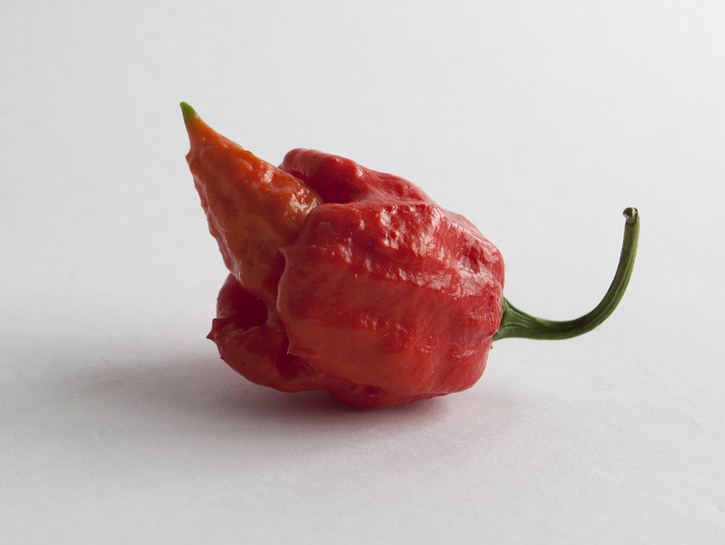People have different tolerances for spicy foods. Chili peppers, jalapenos, and habaneros are some common varieties cultivated and used in dishes regularly. These peppers are enough to make anyone start sweating and lunging for a glass of milk to counterbalance the fire blazing in your mouth. Imagine a pepper even hotter than one you’ve probably tried and even hotter than the feared ghost pepper. The Trinidad Moruga Scorpion pepper is one of the newest and hottest peppers on the block.
How A Pepper’s Heat Is Measured

Scientists aren’t chomping away with tears pouring down their faces trying to quantify which of the world’s peppers are hotter exclaiming, “Well, I can barely feel my lips when I eat the Ghost Pepper but can’t feel them at all when eating the Carolina Reaper so it’s definitely hotter”. American pharmacist Wilbur Scoville developed the aptly named Scoville Scale to determine the spiciness of foods using Scoville Heat Units (SHU) *as their measurements. The test determines how concentrated the chemical *capsaicin, which creates the heat, is within a sample of a pepper. So the higher the SHU is, the hotter the variety of pepper is.
Get To Know Your Pepper

The little red pepper gets its name from the distinctive tip or “tail” that mirrors that of a real scorpion. They are usually wrinkled and grow about 1 – 2 inches.
The scorpion pepper averages 1,500,000 SHU, though it can get as hot as 2,000,000 SHU. Just for comparison: ghost peppers have about 1,000,000 SHU; Cayennes are about 40,000 SHU; and jalapenos range from 2,500 – 8,000 SHU. Scorpion peppers hail from Trinidad and Tobago, a two-island country off of the Venezuelan coast. In February 2012, the Trinidad Moruga Scorpion pepper was declared the hottest pepper by the Guinness World Records. It has since lost its seat to the Carolina Reaper.
Can You Eat A Scorpion Pepper Whole?

The short answer: you absolutely should not. Although the pepper isn’t lethal (it would take 2.7 pounds of it to kill a 150-pound person), the effects are super painful. Because the heat is so intense, blisters will begin to form in your mouth as a way to absorb and protect you from that pesky chemical capsaicin.
According to an interview of Paul Bosland, professor of horticulture at New Mexico State University and director of the Chile Pepper Institute, “These peppers contain so much capsaicin that the chemical permeates the blisters and keeps activating receptors in the nerve endings underneath, causing ferocious burning sensations for 20 minutes or more. So don’t think you are clever and double dog dare your buddy to eat one – it has serious physical ramifications.
Recipes
No one wants to endure the pain of eating a whole pepper but that doesn’t mean you can’t use them in dishes! Cooking, blending, and diluting the intensity are all ways to utilize this sultry vegetable without sending you to the hospital. *When using any hot pepper, though, make sure you always wear gloves! The juices are hard to wash off and can linger even after soap and water are applied. *Also, remember that a little bit goes a long way when it comes to the scorpion pepper! It is better to start with a little, taste, then add more if it doesn’t jolt your hot meter enough.
Salsa

This simple salsa recipe basically replaces commonly used jalapenos for the rare scorpion. Start with half of the actual pepper to taste how well you can handle it then add more if you want. The tomatoes help counter the intense heat.
Blueberry Pepper Sauce

The fruity tartness of the berries help to balance the pepper’s heat. It also gives this distinct pepper sauce a beautiful color uncommon to most. Although this recipe calls for 6 peppers, remember you only use a drop or two at a time to please your palette.
Pepper Jelly

Although this recipe technically calls for a ghost pepper, you can turn things up a notch with the scorpion pepper. The vinegar and sugar give this jelly a richness. Put some over a hunk of cream cheese and you’ve got yourself a great Christmas appetizer!
Scorpion Rum Wings

This recipe is for true hot wings! It uses chipotle and habanero peppers, the less intense cousins of the scorpion, with a splash of dark rum. When using the scorpion pepper, only use a quarter of the pepper then add more if you want it hotter. The result is a sticky, spicy treat that will leave the patrons dipping for the blue cheese and munching on celery!
Inferno Soup

This soup will really clear out your sinuses! It uses a host of peppers, including the scorpion pepper, which are dried and added to this Asian soup. The temperature of the soup along with the internal heat of the peppers will certainly clean out your pores.
Just like the actual scorpions, the pepper version should be handled with delicacy and caution. However, they are not to be feared! They have a role in the culinary world just like their namesake does in the ecological world. So explore them even if you are trepidatious!
